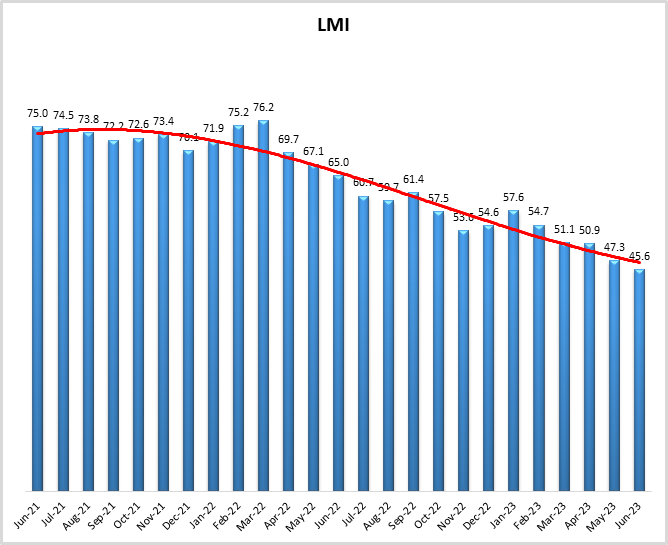
June 2023 Logistics Manager’s Index Report®
- LMI® at 45.6
- Growth is INCREASING AT AN INCREASING RATE for: Warehousing Capacity, Warehousing Utilization, Warehousing Prices, and Transportation Capacity
- Growth is INCREASING AT AN DECREASING RATE for: Inventory Costs
- Inventory Levels, Transportation Utilization, and Transportation Prices ARE DECREASING
For the second time in a row the Logistics Managers’ Index registers as contracting – coming in at 45.6. This is the fourth consecutive month that the index has reached a new all-time low.
Our inventory metrics are at the forefront of this decline. Inventory Levels is contracting (-6.5) at 42.9 which is the second fastest rate in the history of the index and the growth rate for Inventory Costs is down (-7.3) to 57.1. The dip in inventories has led to an increase in Warehousing Capacity (+6.8) and Transportation Capacity (+1.9), both of which contribute to a decrease in the overall metric. Transportation Utilization and Transportation Prices are contracting, but at reduced rates from what we saw in May.
Researchers at Arizona State University, Colorado State University, Florida Atlantic University, Rutgers University, and the University of Nevada, Reno, and in conjunction with the Council of Supply Chain Management Professionals (CSCMP) issued this report today.
Results Overview
The LMI score is a combination of eight unique components that make up the logistics industry, including: inventory levels and costs, warehousing capacity, utilization, and prices, and transportation capacity, utilization, and prices. The LMI is calculated using a diffusion index, in which any reading above 50.0 indicates that logistics is expanding; a reading below 50.0 is indicative of a shrinking logistics industry. The latest results of the LMI summarize the responses of supply chain professionals collected in June 2023.
When taken as a whole, Q2 economic data was strong in the U.S. – if not in the freight sector. For instance, new home sales are up, unemployment rate is down, and Q1 GDP growth has been revised up to 2% growth with Q2 growth predicted to be around 1.7%. much of this has been spurred by consumer spending, which was up at 4.2% in Q1 – the highest positive rate of change since the end of lockdowns in mid-2021[1]. This is at least partially reflected on the continually higher rates of expansion (or at least slower rates of contraction) that we are often seeing from our Downstream relative to Upstream respondents.
Consumers are “downshifting” but spending is still robust – particularly when compared to the rest of the world[2]. This is somewhat buoyed by consumer sentiment which improved significantly in June, reading in at 64.4 according to the University of Michigan’s Consumer Sentiment Index. This reading is up 8.8% from May and 28.8% year-over-year[3], suggesting that consumers are not nearly as worried about a recession as they were a year ago when inflation was driving up prices. Despite this, inflation continues to run higher than most central banks would prefer. The personal-consumption expenditures index read in at 3.8% in May. This is the lowest reading on this metric in two years but still higher than what the Federal Reserve would like to see2. Because consumer savings were robust going into 2022 the high levels of interest have done less to curb spending than would be normally be expected. Due to these unique factors, Atlanta Fed President Raphael Bostic believes that only the most recent few months of interest rates actually did anything to truly slow overall economic growth[4]. This, along with the long-tail effect in which interest rate increases may have somewhat delayed reactions, is behind Chairman Powell’s recent statements that the Fed will put forth two more rate increases this year as they do not expect inflation to reach their goal of 2% until 2025[5]. Bank of America is more bullish on inflation coming down, pointing to the steep inversion of the Treasury yield curve, which suggests that investors believe the Fed will eventually begin pulling interest rates back and avoid an overall recession[6].
Taken together, Wall Street is somewhat optimistic about the state of the economy as well as the stock market had its best six months of the year since 1983. However it should be noted that much of that growth is coming from the service sector – which is less reliant on trucks and warehouses then goods[7]. This dynamic is reflected in the complicated nature of the current economy. While the freight recession has been on for over a year at this point, the overall recession that many prognosticators predicted has yet to occur. This is reflected in the fact that despite these strong economic indicators, the overall LMI reads in at 45.6, which is down (-1.7) from the previous all-time low of 47.3 recorded in May. However, it should also be pointed out that LMI respondents are somewhat optimistic that this will take a turn, predicting an expansion rate of 55.4 over the next 12 months – a reading that is 5.8-points more optimistic than the future prediction of 49.6 and contraction from May.
Inventory metrics were the big movers in June. Inventory levels continued their downward movement, dropping (-6.5) to 42.9, which is the second-lowest reading in the history of this metric. Seasonality would suggest that this value should come up soon, but there are some signals that that might not happen. Traditionally we see consumers move from bulkier goods that may require financing (i.e. lawn furniture) in the summer towards smaller goods (i.e. back-to-school items, clothing, and toys) during the back half of the year. Smaller goods have been moving faster throughout the year – as evidenced by the stronger inventory and transportation numbers we have seen for most of 2021. While this could theoretically lead to more volume in Q3 and Q4, there does not appear to be a large glut of holiday inventory on the way. The Chinese manufacturing PMI read in at 49.0 in June. This marks three consecutive months of contraction in what is often the ramp up for back-to-school and holiday production. The overall Chinese PMI is positive at 53.2, but is the weakest reading of 2023 – casting doubt on any significant increases in Chinese economic production[8]. Container imports are down from the highs of 2021 and 2022, but according to analysis by Michigan State professor (and friend of the index) Jason Miller, the volumes we are seeing now are up 7.4% from 2019 – exactly in line with the predicted level of growth that would have occurred have the COVID disruptions never happened[9]. Due to the contraction (which some would call “right-sizing”) of inventories, Inventory Cost growth dipped in June, slowing (-7.3) to 57.1 which is a noticeably slower rate of contraction.
Some retailers may be nervous about restocking due to uncertainty regarding the impact of the Supreme Court’s decision to strike down the Biden administration’s student loan forgiveness plan – and the $430 billion that will need to be paid back by the 16 million people that had been approved for the program[10]. Some retailers are bracing for consumers to pull back on discretionary spending on items such as clothing. This shift comes at an inconvenient time for retailers as payments are scheduled to resume right at the start of the back-to-school season which is historically a robust period for clothing sales[11].
The reduction in inventories is having a clear impact on the warehousing sector. Warehousing Capacity expanded (+6.8) to a growth rate of 63.5. This is the fastest rate of expansion for this metric in the history of the index, and only the second time it has read in the 60’s (the other occurrence was February 2020 as Chinese imports began to dry up due to lockdowns). Despite this abundance of capacity Warehousing Utilization increased it’s rate of growth, increasing (+2.1) to 56.8 in June. Despite the reduction of inventories, some firms are clearly betting that a move back towards season spending on goods and an increase in ecommerce will lead to more demand down the road. This seems to have been the thinking behind Prologis’ late June acquisition of $3.1 billion portfolio of warehouse and distribution assets from Blackstone. Prologis president Dan Letter mentioned the continued importance of ecommerce and last-mile delivery to the firm’s recent growth. That this portfolio includes several facilities in major markets seems to suggest that Prologis sees more room for growth in industrial real estate oriented around ecommerce[12]. They might also be encouraged by the continued expansion in Warehousing Prices. This metric has been the most consistent growth area throughout is up (+0.6) to 63.3 and has now read in above 60.0 for 39 consecutive months. Capacity may be increasing, but rates continue to rise. There are several factors behind this. One is the long-term nature of warehousing contracts, meaning that some firms are still paying higher than market rates. Based on an analysis of large and small firms that will be discussed below, this seems to be particularly true for larger firms. Another potential factor for the continued growth in real estate prices is that unlike in previous economic downturns there have not been “doom spirals” of banks or other financial entities that owned large portfolios, preventing a flood of defaulted assets from entering the market[13].
The freight market remains challenging. After a one month reprieve in the 60’s Transportation Capacity is back up (+1.9) to 71.2 and above 70.0 – where it has been for almost all of 2023. Despite the excess capacity and low prices, the exits from the freight market that we would have expected to see have not yet materialized. However, Yellow Corp.’s ongoing issues do have some analysts considering what the impact of a potential bankruptcy would be on the overall market. Yellow has seen tonnage drop by 16% year-over-year and more than double that from the same period in 2021. They recently requested a delay in welfare and pension contributions from the union workers (which was unsurprisingly turned down) due to the fear they will run out of cash by mid-summer[14]. If a bankruptcy were to happen at the third-largest LTL carrier in the U.S., capacity might begin to tighten and spot-market prices may begin to stabilize. Capacity could also be impacted by a potential strike at UPS. In the last week of June, the 330,000 UPS workers represented by The Teamster’s rejected UPS’s latest offer. However, negotiations have continued and the two sides are hopeful that a deal will be agreed on shortly after the Fourth of July. If the sides do not reach an agreement, it is likely that The Teamsters will strike when their contract expires at the end of July[15]. While the decrease in available trucking capacity could be a boon to some carriers, UPS need only to look at the problems currently being faced by Yellow Corp and their ongoing labor and restructuring issues (oh which labor is admittedly only one element of their financial issues) to see what the consequences of not reaching a deal could be14.
It is unsurprising that the glut of capacity has led to continued contraction in Transportation Utilization (+1.3) which reads in at 46.8 which is it’s second consecutive month of contraction – although this month is slower rate of contraction relative to what we observed in May. Contraction may be slowing due to the national tender rejection rate hovering between 2.5-3.2% through the start of summer, with some expected upward movement as we approach the Fourth of July holiday. Interestingly, we do see some spot rates increasing, particularly for outbound freight from large markets such as Phoenix or Memphis[16]. Spot markets still linger well behind contract rates – potentially explaining some of the discrepancies we will see below between large and small carriers. Transportation Prices continue to decrease rapidly at 32.8, but at least that reading is 4.8-points higher than May’s record contraction rate of 27.9. Beyond excess capacity, it is likely that the falling price of diesel, which is down to $3.80 per gallon in the last week of June – $1.98 cheaper than this time a year ago[17] has contributed to continually falling prices as well.
Evidence of a return to normal can be seen in data from the U.S. Census Bureau tracking the seasonally adjusted inventory to sales ratio for total business inventories for 2015-2023[18]. When inventory to sales ratios are elevated, as in the Spring of 2020, firms have more inventory on-hand than they can sell. When inventory to sales ratios dip, as in the summer of 2021, firms are selling inventory very quickly and may be having a difficult time keeping items on the shelf. The dashed red line represents the average inventory to sales ratio from 2015-2019, the five-year period before supply chains were thrown out of whack by COVID-19. After the whirlwind of the last few years, it appears that firms are getting back to the inventory to sales ratios that they saw pre-pandemic – something they had been striving to do through 2021 and 2022. The overriding issue in the logistics industry is that during that whirlwind a large volume of warehousing and freight capacity was brought online, some of which is not currently being utilized as things get back to normal. There is still a mismatch between capacity and demand, but if – as this chart suggests – demand is beginning to stabilize, then supply chains should have an easier time right-sizing their logistics capacity going forward.
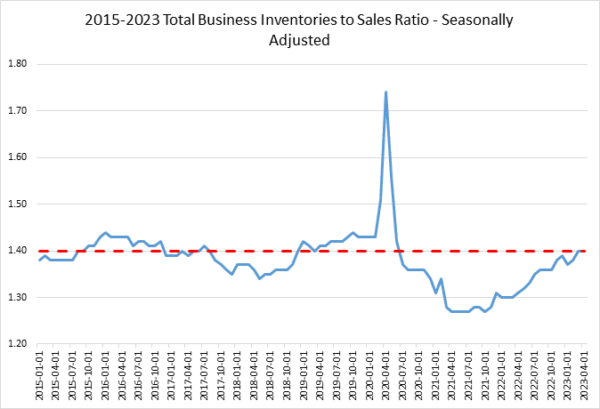
The index scores for each of the eight components of the Logistics Managers’ Index, as well as the overall index score, are presented in the table below. The overall LMI is contracting at its fastest rate ever. Similar to May, three of the eight sub-metrics are contracting this month. In the reverse of what we saw last month, four of the five metrics that are expanding are doing so at an increased rate. Only Inventory Costs are expanding at a slower rate than what we saw in May.
| LOGISTICS AT A GLANCE | |||||
| Index | June 2023 Index | May 2023 Index | Month-Over-Month Change | Projected Direction | Rate of Change |
| LMI® | 45.6 | 47.3 | -1.7 | Contracting | Faster |
| Inventory Levels | 42.9 | 49.5 | -6.5 | Contracting | Faster |
| Inventory Costs | 57.1 | 64.4 | -7.3 | Expanding | Slower |
| Warehousing Capacity | 63.5 | 56.7 | +6.8 | Expanding | Faster |
| Warehousing Utilization | 56.8 | 54.7 | +2.1 | Expanding | Faster |
| Warehousing Prices | 63.3 | 62.8 | +0.6 | Expanding | Faster |
| Transportation Capacity | 71.2 | 69.3 | +1.9 | Expanding | Faster |
| Transportation Utilization | 46.8 | 45.5 | +1.3 | Contracting | Slower |
| Transportation Prices | 32.8 | 27.9 | +4.8 | Contracting | Slower |
Continuing the trend we have observed throughout most of 2023 we see more activity from our Downstream (orange bars) than from our Upstream (blue bars) respondents. The only statistically significant difference we observe is the 13.8-point faster expansion in Warehousing Capacity by Upstream firms. However, we also observe a slower rate of inventory decline for Downstream firms and an increase in Transportation Utilization compared to contraction from their Downstream counterparts. This aligns with other evidence that consumers continue to spend more money with retailers on smaller goods, while larger bulk items being transferred B2B is still slow. This difference does not appear to be as pronounced as it was a few months ago, but there is still clearly more activity Downstream than Upstream. If we are truly seeing a return to normal patterns of demand and seasonality, we would expect Downstream activity to increase starting at the end of summer. Whether or not that will actually happen remains to be seen.
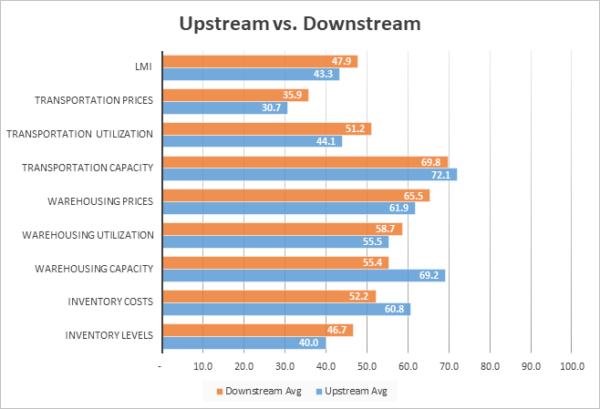
| Inv. Lev. | Inv. Costs | WH Cap. | WH Util. | WH Price | Trans Cap | Trans Util. | Trans Price | LMI | |
| Upstream | 40.0 | 60.8 | 69.2 | 55.5 | 61.9 | 72.1 | 44.1 | 30.7 | 43.3 |
| Downstream | 46.7 | 52.2 | 55.4 | 58.7 | 65.5 | 69.8 | 51.2 | 35.9 | 47.9 |
| Delta | 6.7 | 8.7 | 13.8 | 3.2 | 3.6 | 2.4 | 7.1 | 5.2 | 4.5 |
| Significant? | No | No | Yes | No | No | No | No | No | No |
Respondents were asked to predict movement in the overall LMI and individual metrics 12 months from now. Expectations have been trending towards things “going back to normal” for most of 2023, that trend become even more pointed in June as all future metrics read in between 53.7 and 62.8 – all of which we would consider to be healthy levels of expansion. The reading of 59.1 for Transportation Price is the highest we have seen in 2023. When combined with the expectation of moderate Transportation Capacity expansion at 57.0, it is clear that our respondents are anticipating a rebalancing of the freight market over the next 12 months. In another shift from May, respondents also now anticipate that Inventory Levels will grow rather than contract, with associated increases in Inventory Costs and warehousing metrics coming along with them. Essentially, respondents believe that the future outlook is sunny, if somewhat muted compared to the wild swings we have seen from 2020-2023. This regression back towards the mean is consistent with what we observe in imports and overall business inventories. Whether this will also require significant freight capacity leaving the market remains to be seen. What is clear though is that LMI respondents, much like U.S. consumers, are feeling better about the economic situation of the next 12 months than they have in quite some time.
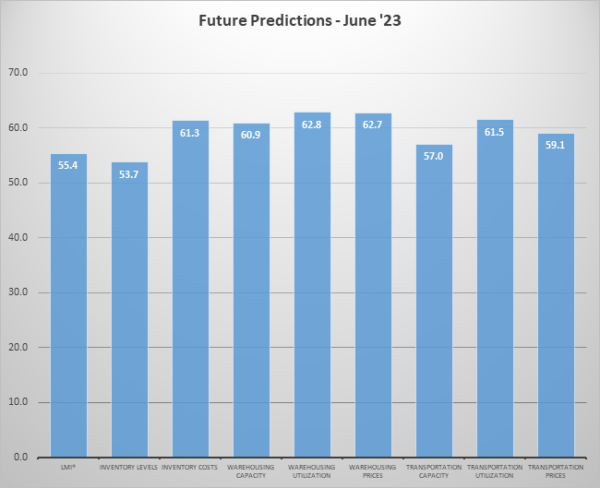 Interestingly, Upstream (green bars) and Downstream (purple bars) respondents are in relative agreement regarding their future predictions. The only significant difference we see is with anticipated Warehousing Capacity, where Upstream firms (66.9) are anticipating significantly more space coming online than their Downstream counterparts (52.2). More capacity may be necessary as Upstream firms are also predicting more growth across both inventory metrics. Conversely, Downstream firms expect slightly greater levels of growth across all three transportation metrics. The key takeaway however is that for the first time in many years, respondents are predicting growth across every metric regardless of their position in the supply chain.
Interestingly, Upstream (green bars) and Downstream (purple bars) respondents are in relative agreement regarding their future predictions. The only significant difference we see is with anticipated Warehousing Capacity, where Upstream firms (66.9) are anticipating significantly more space coming online than their Downstream counterparts (52.2). More capacity may be necessary as Upstream firms are also predicting more growth across both inventory metrics. Conversely, Downstream firms expect slightly greater levels of growth across all three transportation metrics. The key takeaway however is that for the first time in many years, respondents are predicting growth across every metric regardless of their position in the supply chain.
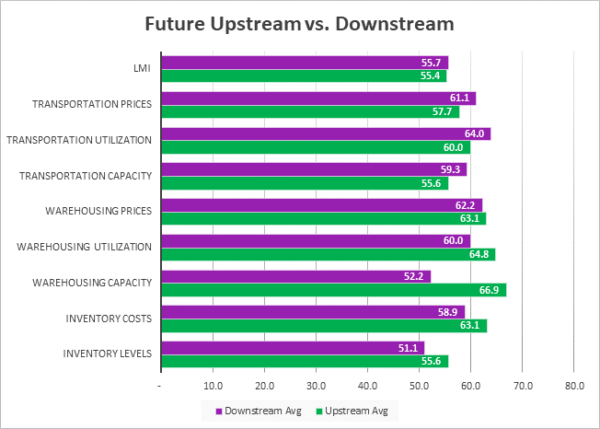
| Futures | Inv. Lev. | Inv. Costs | WH Cap. | WH Util. | WH Price | Trans Cap. | Trans Util. | Trans Price | LMI |
| Upstream | 55.6 | 63.1 | 66.9 | 64.8 | 63.1 | 55.6 | 60.0 | 57.7 | 55.4 |
| Downstream | 51.1 | 58.9 | 52.2 | 60.0 | 62.2 | 59.3 | 64.0 | 61.1 | 55.7 |
| Delta | 4.5 | 4.2 | 14.7 | 4.8 | 0.9 | 3.7 | 4.0 | 3.4 | 0.2 |
| Significant? | No | No | Yes | No | No | No | No | No | No |
To add additional nuance to our analysis we broke respondents down by Larger firms (those with 1,000 employees or more, represented by gold lines) relative to smaller firms (those with 0-999 employers, represented by maroon lines). Statistically significant differences emerged for Inventory Costs, Warehousing Prices, and overall LMI. Larger firm readings came in higher for all three of these metrics. Larger firms also reported much slower rates of contraction in Inventory Levels and Transportation Prices, faster growth in Warehousing Utilization, and growth in Transportation Utilization while smaller firms saw contraction. Essentially, it seems that larger firms are busier than their smaller counterparts. It is interesting that the significance comes from cost metrics (inventory and warehousing). It may represent greater investments in infrastructure and/or higher-cost, long-term contract rates. It will be interesting to continue monitoring this split moving forward.
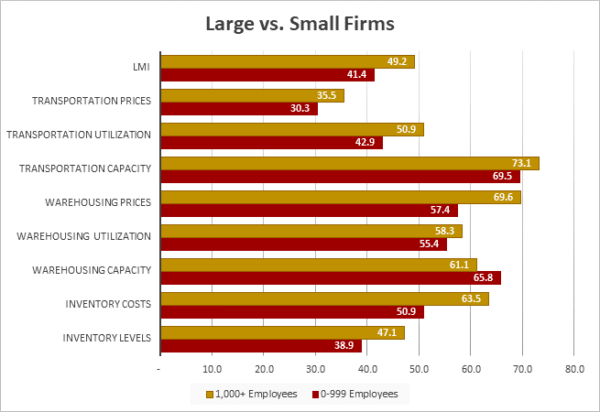
| Employees | Inv. Lev. | Inv. Costs | WH Cap. | WH Util. | WH Price | Trans Cap. | Trans Util. | Trans Price | LMI |
| 0-999 | 38.9 | 50.9 | 65.8 | 55.4 | 57.4 | 69.5 | 42.9 | 30.3 | 41.4 |
| 1,000+ | 47.1 | 63.5 | 61.1 | 58.3 | 69.6 | 73.1 | 50.9 | 35.5 | 49.2 |
| Delta | 8.2 | 12.5 | 4.7 | 3.0 | 12.2 | 3.7 | 8.1 | 5.1 | 7.8 |
| Significant? | No | Yes | No | No | Yes | No | No | No | Yes |
Historic Logistics Managers’ Index Scores
This period’s along with prior readings from the last two years of the LMI are presented table below:
| Month | LMI | Average for last 3 readings – 48.0
All-time Average – 63.4 High – 76.2 Low – 45.6 Std. Dev – 7.89
|
| June ‘23 | 45.6 | |
| May ‘23 | 47.3 | |
| Apr ‘23 | 50.9 | |
| Mar ‘23 | 51.1 | |
| Feb ‘23 | 54.7 | |
| Jan ‘23 | 57.6 | |
| Dec ‘22 | 54.6 | |
| Nov ‘22 | 53.6 | |
| Oct ‘22 | 57.5 | |
| Sep ‘22 | 61.4 | |
| Aug ‘22 | 59.7 | |
| July ‘22 | 60.7 | |
| June ‘22 | 65.0 | |
| May ‘22 | 67.1 | |
| Apr ‘22 | 69.7 | |
| Mar ‘22 | 76.2 | |
| Feb ‘22 | 75.2 | |
| Jan ‘22 | 71.9 | |
| Dec ‘21 | 70.1 | |
| Nov ‘21 | 73.4 | |
| Oct ‘21 | 72.6 | |
| Sep ‘21 | 72.2 | |
| Aug ‘21 | 73.8 | |
| July ‘21 | 74.5 | |
| June ‘21 | 75.0 |
LMI®
For the fourth consecutive month, the overall LMI has reached a new all-time low, reading in at 45.6 and contracting for only the second time in the history of the index. This overall score is down (-1.7) from May’s reading of 47.3. It is also down 19.4-points from the reading of 65.0 that we recorded this time last year and 29.4-points down from June 2021’s reading of 75.0. This reduction was largely due to decreases in the inventory metrics as well as associated warehousing statistics. significant drops for all three transportation metrics as well as Inventory Levels moving from years of expansion to contraction. Both Upstream and Downstream firms showed contraction. Larger firms showed contraction as well but at a much lower rate than their smaller counterparts at a difference of 49.2 to 41.4.
Interestingly, respondents expect the contraction to cease over the next 12 months, predicting a moderate expansion of 55.4 which is up (+5.8) from May’s future prediction of 49.6. While this prediction is below the all-time average of 63.4 it would represent a welcome change from the ongoing slide we have seen in the logistics industry over the last 15 months.
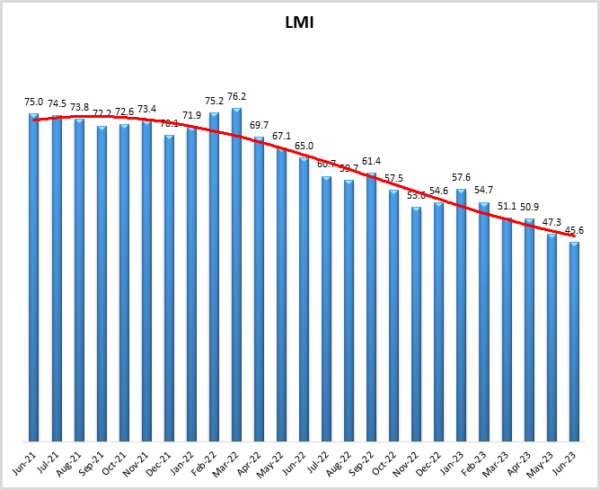
Inventory Levels
The Inventory Level value is 42.9, down (-6.6) from May’s value of 49.5. This reading is down 28.9 points lower than the same time last year, and down 24.9 from two years ago – highlighting the dramatic shift in inventories we have seen over the last two years. This is the second lowest value (behind only December 2019’s reading of 42.3) in the history of this metric. This month, both upstream (40.0) and downstream (46.7) respondents reported inventory declines, while upstream showed a slight contraction. Last month, downstream respondents reported modest inventory growth, while upstream showed a similarly modest contraction (54.4 vs 46.7). This month, for the first time, we have separated out the responses from larger vs smaller firms. Small firms had an average response of 38.9, while larger firms had an average of 47.1. It would seem that smaller firms are seeing a larger reduction in inventories than larger firms. Or perhaps larger firms have reached the lowest point of their inventory levels and are starting to rebuild inventories.
When asked to predict what conditions will be like 12 months from now, the average value is 53.7, up (+9.0) from May’s future prediction of 44.7 which suggests firms have become more bullish about the economy and are planning on rebuilding inventories over the next year. This was especially the case for Upstream respondents who returned a value of 55.6, while Downstream was similar but slightly lower at 51.1.
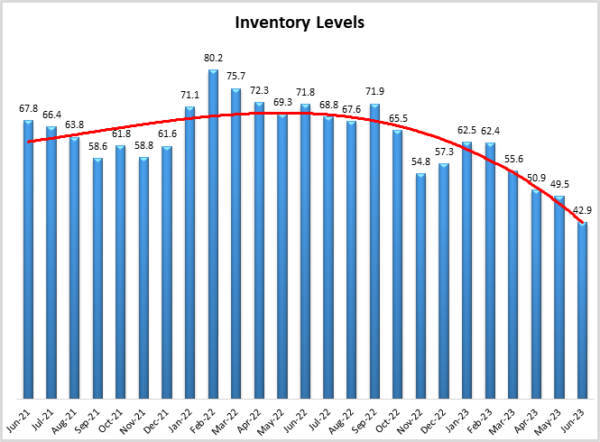
Inventory Costs
The current Inventory Costs index value reads in at 57.1, down (-7.3) from May’s reading of 64.4. Inventory cost values have fallen considerably over the last two years. The value is down 26.7 points from the value last year, and down 32.3 compared to two years ago. It will be interesting to see if this trend continues as this metric has never registered a value below 50.0 in the history of the index. Consistent with their high costs of storage this month Upstream respondents reported an average of 60.8, and Downstream respondents reported an average of 52.2. This is a significant drop for Downstream respondents who had reported in at 62.5 in May. We also see that the costs differ depending on firm size. Small firms had an average response of 50.9, while larger firms had an average of 63.5. The smaller firms are just barely seeing increased costs, while larger firms are seeing significant increases.
Above, we saw that respondents expect inventory levels to increase slightly over the next 12 months (53.7). It is therefore not surprising that inventory costs are expected to also grow (61.3). Upstream returned a value of 63.1, while downstream respondents returned a value of 58.9. The average value of 61.3 is higher than the current cost number of 57.1.
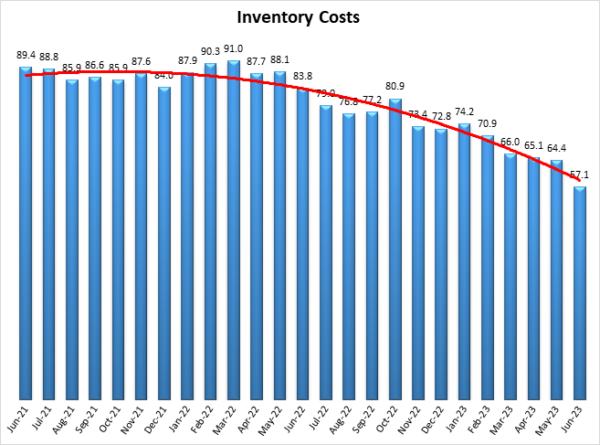
Warehousing Capacity
The reading for the June 2023 Warehousing Capacity index is up (+6.8) from May’s reading of 63.5. This reading is also up a staggering 22.5 points from the reading one year ago, and nearly 23 points from the reading from two years ago. In fact, this is the fastest rate of expansion we have recorded for this metric in the 6.5-year history of the LMI. Additionally, when we look at the Upstream (69.2) vs Downstream (55.4) difference of over 13 points (which is statistically significant) the magnitude and source of this difference becomes clear. Also worth noting, is that while the difference is not statistically significant, larger firms saw a slightly slower rate in capacity (61.1) expansion than their smaller counterparts (65.8).
Future predictions suggest prices growth will continue to moderate as respondents are expecting prices to continue to grow at a rate of 60.9, relatively consistent (+0.4) with May’s future prediction of 60.5. Upstream firms are anticipating significantly more capacity than their Downstream counterparts at a rate of 66.9 to 52.2. This could be partially due to the ongoing busyness at retailers, and some Upstream firms seeing contracts expire – leading to more excess space – over the next 12 months.
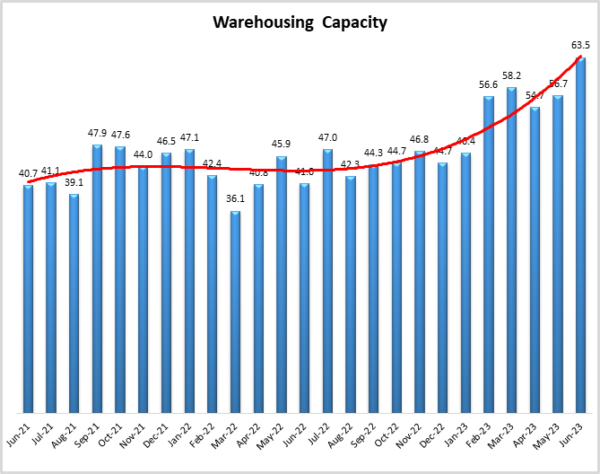
Warehousing Utilization
Warehousing Utilization reads in at 56.8, which is up (+2.1) from May’s reading of 54.7. This reading breaks a three-month trend of declining expansion for this metric. In addition, this value is down 13.7 percentage points from the reading one year ago, and down nearly 20 points from the reading two years ago. It also appears that while there was a slight difference between the upstream (55.5) and downstream (58.7) values for this metric, the difference of 3.2 points was not statistically significant, potentially indicating an across-the-board increase in utilization rates. Further, the difference between large firms and small firms for this measurement was modest, 58.3 and 55.4 respectively, and not statistically significant.
Looking forward at the next 12 months, the predicted Warehousing Utilization index is 62.8, this is up significantly (+11.8) from May’s future prediction of 51.0 and is a marked shift away from the downward trend towards contraction we had been observing over the last few months. This is consistent with respondent anticipation of increased inventories over the next 12 months.
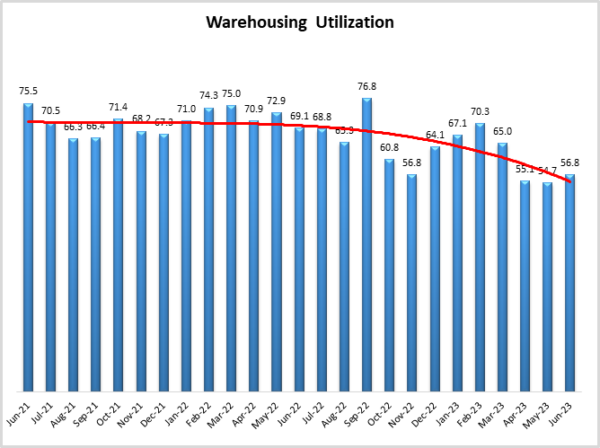
Warehousing Prices
The Warehousing Price index reads in at 63.3, down negligibly (-0.5) from May’s reading of 62.8. This marks a 14.9-point decrease from the reading one year ago and a decrease of 22.1-points from the reading two years ago. These continued and persistent price increases appear to be universally impacting both the upstream (61.9) and downstream (65.5) as the difference between the two is not statistically significant. Conversely the spread between small firms (57.4) and large firms (69.6) is rather large and statistically significant. Taken together the data for warehousing tell a rather interesting story. This is the fifth month in a row where the rate at which capacity for warehousing is increasing in spite of a downward trend on the rate of growth of pricing and utilization. In addition, we also observe that larger firms are feeling the price increases more so than the smaller firms, potentially indicating a pricing imbalance in the market. So, is this relationship circular: is the market perceiving that the persistent increases in price necessitate continued capacity to come online, or, despite the increased capacity coming online does the market perceive that the future demand will continue to grow in spite of these persistent price increases? The latter would be more in line with what our respondents have suggested, signaling that in all three of these metrics future growth is expected to be higher. Time will tell, however, the larger macroeconomic environment and continued interest rate increases and shifting consumer debt burdens may be canaries in the calming for how accurate the future optimism should be.
Future predictions suggest prices growth will continue to moderate as respondents are expecting prices to continue to grow at a rate of 60.9, relatively consistent (+0.4) with May’s future prediction of 60.5 as well as the notion that inventories will increase and warehouses will stay busy over the next year.
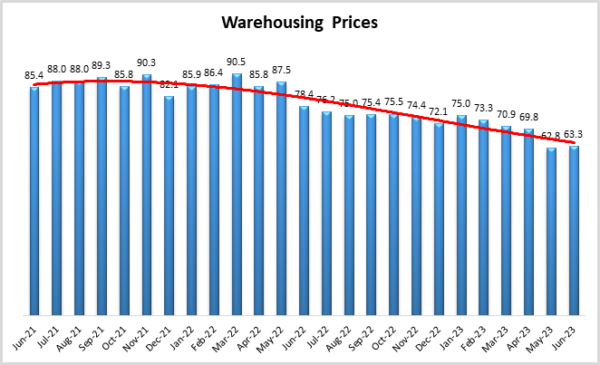
Transportation Capacity
The Transportation Capacity Index registered 71.2 in June 2023. This constitutes a small increase of 1.9 percentage points from the May reading of 69.3. As such, the Transportation Capacity Index continues to remain elevated and near all-time highs. There is no significant difference between the Upstream Transportation Capacity index (72.1) and the Downstream index (69.8).
The future Transportation Capacity index indicates 57.0 corresponding to a very small change of .1 points from the previous reading of 56.9. The Downstream future Transportation Capacity index is at 59.3 while the upstream future Transportation Capacity index is at 55.6. These moderate levels of growth would signal a marked shift in the direction of the freight market, suggesting respondents predict a rebalancing of capacity and demand in the near future.
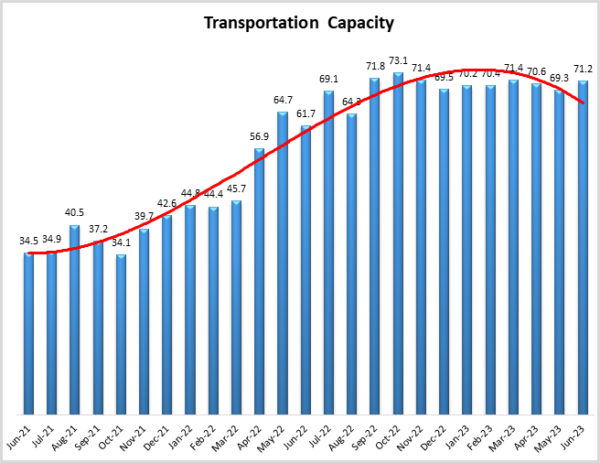
Transportation Utilization
The Transportation Utilization Index registered 46.8 in June 2023. This denotes a small rebound of 1.3 points from the significant drop we saw last month. Despite this increase, the Transportation Utilization index remains in the contraction territory. This contraction is driven by Upstream firms where the index is shrinking at a rate of 44.1, as the Downstream Transportation Utilization Index reads in at 51.2 and expansion. This difference is partially due to continued consumer spending on ecommerce, which is a continuation of trends we have seen throughout 2023.
The future Transportation Utilization Index increased a significant 11.5 points from the previous reading and indicates a 61.5 level for the next 12 months. As such, expectations of increased transportation activity over the near future have returned. This reading goes hand-in-hand with the other optimistic predictions we have seen for our transportation metrics. This optimism is spread across the supply chain, with the future Downstream Transportation Utilization index indicating expansion at 64.0 and the Upstream Transportation Utilization index indicates contraction at 60.0.
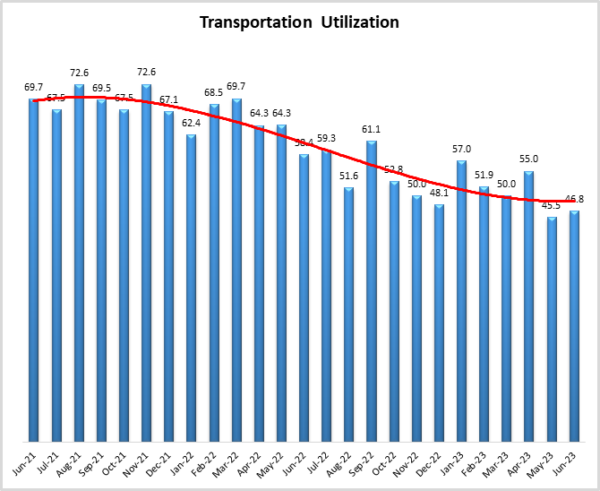
Transportation Prices
The Transportation Prices Index indicates a rebound of 4.9 points this month, moving away from the all-time low of 27.9 registered in May. Hence, the downward pressure on transportation prices has eased a little but remains strongly in place at the present time. The Downstream Transportation Prices index is at 35.9, while the Upstream reads in at 30.7. There was no significant difference between all large and small respondents, but when we zoom in on only transportation and logistics companies – which we discuss below – some patterns do emerge.
The future index for transportation prices pushed above the critical level and is now at 59.1, which is up significantly (+11.6) from May’s future prediction of 47.5, indicating expectations of slightly higher Transportation Prices in the next 12 months. The Downstream Transportation Prices index is at 61.1 while the Upstream Transportation Prices index is at 57.7. When taken together, June’s future predictions paint a much rosier picture of the freight market than what we are currently seeing.
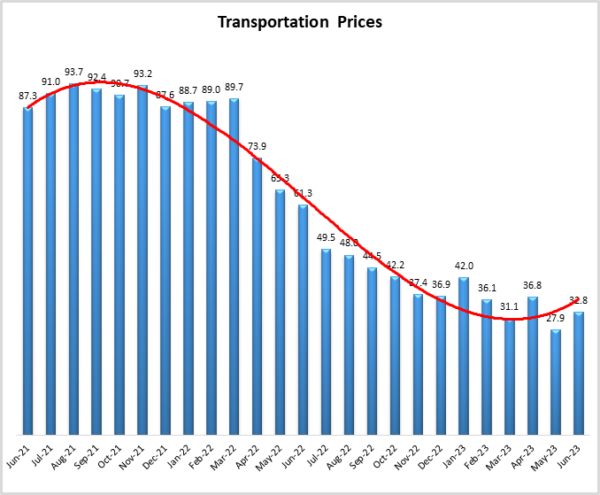
To better understand the nuances of the freight market we broke down data from respondents identifying as being in the “Transportation” and “Logistics” industries by size. Respondents were divided into firms with 100 employees or less (blue bars), 101-999 employees (orange bars), and firms with over 1,000 employees (gray bars). Generally, when freight recessions go on for long periods of time we see many small carriers drop out of the market (as happened from 2018-2019). However, anecdotal evidence suggests that many of the small carriers are currently holding on due to contracts with smaller customers that are providing them with relatively stable volumes. Evidence that smaller carriers are being propped up by contract weights can be seen in the breakdown of Transportation Price movement by size. While large- and mid-sized carriers are seeing contraction, smaller carriers are actually seeing Transportation Prices break even at 50.0, despite their lower levels of utilization. It is not clear if smaller carriers will drop out of the market once their contracts are up, or if as was hypothesized on a recent FreightVines podcast[19], that smaller carriers are existing in a separate, more stable ecosystem fed by smaller shippers. We will continue to monitor this size-based split and attempt to come to a conclusion on this difference.
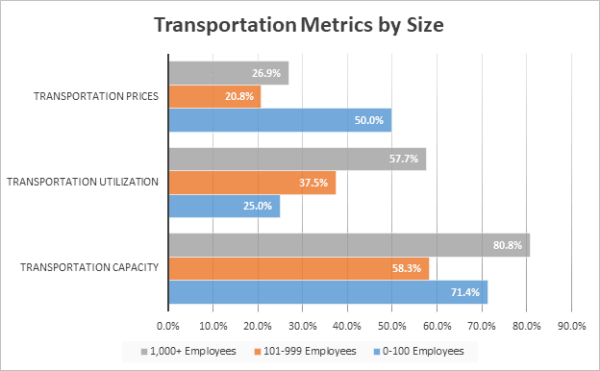
About This Report
The data presented herein are obtained from a survey of logistics supply executives based on information they have collected within their respective organizations. LMI® makes no representation, other than that stated within this release, regarding the individual company data collection procedures. The data should be compared to all other economic data sources when used in decision-making.
Data and Method of Presentation
Data for the Logistics Manager’s Index is collected in a monthly survey of leading logistics professionals. The respondents are CSCMP members working at the director-level or above. Upper-level managers are preferable as they are more likely to have macro-level information on trends in Inventory, Warehousing and Transportation trends within their firm. Data is also collected from subscribers to both DC Velocity and Supply Chain Quarterly as well. Respondents hail from firms working on all six continents, with the majority of them working at firms with annual revenues over a billion dollars. The industries represented in this respondent pool include, but are not limited to: Apparel, Automotive, Consumer Goods, Electronics, Food & Drug, Home Furnishings, Logistics, Shipping & Transportation, and Warehousing.
Respondents are asked to identify the monthly change across each of the eight metrics collected in this survey (Inventory Levels, Inventory Costs, Warehousing Capacity, Warehousing Utilization, Warehousing Prices, Transportation Capacity, Transportation Utilization, and Transportation Prices). In addition, they also forecast future trends for each metric ranging over the next 12 months. The raw data is then analyzed using a diffusion index. Diffusion Indexes measure how widely something is diffused or spread across a group. The Bureau of Labor Statistics has been using a diffusion index for the Current Employment Statics program since 1974, and the Institute for Supply Management (ISM) has been using a diffusion index to compute the Purchasing Managers Index since 1948. The ISM Index of New Orders is considered a Leading Economic Indicator.
We compute the Diffusion Index as follows:
PD = Percentage of respondents saying the category is Declining,
PU = Percentage of respondents saying the category is Unchanged,
PI = Percentage of respondents saying the category is Increasing,
Diffusion Index = 0.0 * PD + 0.5 * PU + 1.0 * PI
For example, if 25 say the category is declining, 38 say it is unchanged, and 37 say it is increasing, we would calculate an index value of 0*0.25 + 0.5*0.38 + 1.0*0.37 = 0 + 0.19 + 0.37 = 0.56, and the index is increasing overall. For an index value above 0.5 indicates the category is increasing, a value below 0.5 indicates it is decreasing, and a value of 0.5 means the category is unchanged. When a full year’s worth of data has been collected, adjustments will be made for seasonal factors as well.
About The Logistics Manager’s Index®
The Logistics Manager’s Index (LMI) is a joint project between researchers from Arizona State University, Colorado State University, University of Nevada, Reno, Florida Atlantic University, and Rutgers University, supported by CSCMP. It is authored by Zac Rogers Ph.D., Steven Carnovale Ph.D., Shen Yeniyurt Ph.D., Ron Lembke Ph.D., and Dale Rogers Ph.D.
[1] Robles, C., & Cambon, S. C. (2023, June 29). U.S. Economy Shows Surprising Vigor in First Half of 2023. Wall Street Journal. https://www.wsj.com/articles/
[2] Torry, H., & Timiraos, N. (2023, June 30). U.S. Inflation, Consumer Spending Growth Cooled in May. Wall Street Journal. https://www.wsj.com/articles/
[3] University of Michigan. (2023, June 30). Surveys of Consumers, June 30, 2023. http://www.sca.isr.umich.edu/
[4] Timiraos, N., & Fairless, T. (2023a, June 25). Why Economies Haven’t Slowed More Since Central Banks Hit the Brakes. Wall Street Journal. https://www.wsj.com/articles/
[5] Timiraos, N., & Fairless, T. (2023b, June 28). Powell Says Fed’s Inflation Fight Could Take Years. Wall Street Journal. https://www.wsj.com/articles/
[6] Sor, J. (2023, June 30). The US could see inflation drop like a rock without hitting a recession, Bank of America says. Markets Insider. https://markets.
[7] Grossman, M. (2023, June 30). Economic Optimism Powers Stocks’ Robust First-Half Rally. Wall Street Journal. https://www.wsj.com/articles/
[8] Tan, C. (2023, June 30). China’s factory activity shrinks for a third month as recovery momentum stalls. CNBC. https://www.cnbc.com/2023/06/
[9] Miller, J. (2023, June 28). Containerized Imports Analysis—Post | Feed | LinkedIn. LinkedIn. https://www.linkedin.com/feed/
[10] Ettenheim, R., & Dapena, K. (2023, June 29). Who’s Impacted by the Supreme Court’s Student-Loan Forgiveness Ruling. Wall Street Journal. https://www.wsj.com/articles/
[11] Repko, M. (2023, June 30). Student loan relief is gone for millions of Americans—Here’s what it means for retailers. CNBC. https://www.cnbc.com/2023/06/
[12] Grant, P. (2023, June 26). WSJ News Exclusive | Prologis Buying $3.1 Billion Industrial Property Portfolio From Blackstone. Wall Street Journal. https://www.wsj.com/articles/
[13] Mackintosh, J. (2023, June 30). How Scared Should You Be About Commercial Real Estate? Wall Street Journal. https://www.wsj.com/articles/
[14] Maiden, T. (2023, June 9). Yellow’s tonnage remains in free fall. FreightWaves. https://www.freightwaves.com/
[15] Solomon, M. (2023b, June 30). UPS, Teamsters make ‘significant movement’ on economic terms in contract. FreightWaves. https://www.freightwaves.com/
[16] Strickland, Z. (2023, June 17). Spot rate reactivity on the rise. FreightWaves. https://www.freightwaves.com/
[17] EIA. (2023, June 26). Gasoline and Diesel Fuel Update—June 26, 2023. Gasoline and Diesel Fuel Update. https://www.eia.gov/petroleum/
[18] U.S. Census Bureau. (2023, June 30). Total Business: Inventories to Sales Ratio 2015-2023. FRED, Federal Reserve Bank of St. Louis; FRED, Federal Reserve Bank of St. Louis. https://fred.stlouisfed.org/
[19] Caplice, C., & Miller, J. (2023, June 15). Freightvine on Apple Podcasts (Vol. 103) [Podcast]. https://podcasts.apple.com/us/









